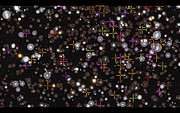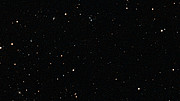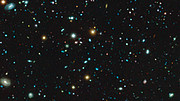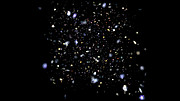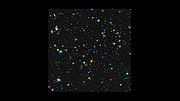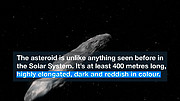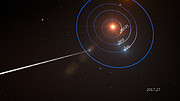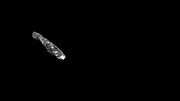The MUSE data provides a new view of dim, very distant
galaxies, seen near the beginning of the Universe about 13 billion years
ago. It has detected galaxies 100 times fainter than in previous
surveys, adding to an already richly observed field and deepening our
understanding of galaxies across the ages.
Another major finding of this study was the systematic
detection of luminous hydrogen halos around galaxies in the early
Universe, giving astronomers a new and promising way to study how
material flows in and out of early galaxies.
More Information
This research was presented in a series of 10 papers to appear in the journal Astronomy & Astrophysics.
The teams are composed of Roland Bacon (CRAL - CNRS,
Université Claude Bernard Lyon 1, ENS de Lyon, Université de Lyon, Lyon,
France), Hanae Inami (CRAL - CNRS, Université Claude Bernard Lyon 1,
ENS de Lyon, Université de Lyon, Lyon, France), Jarle Brinchmann (Leiden
Observatory, Leiden, the Netherlands; Instituto de Astrofísica e
Ciências do Espaço, Porto, Portugal), Michael Maseda (Leiden
Observatory, Leiden, the Netherlands), Adrien Guerou (IRAP, CNRS,
Université Toulouse III – Paul Sabatier, CNES, Université de Toulouse,
France; ESO, Garching, Germany), A. B. Drake (CRAL - CNRS, Université
Claude Bernard Lyon 1, ENS de Lyon, Université de Lyon, Lyon, France),
H. Finley (IRAP, Université de Toulouse, Toulouse, France), F. Leclercq
(University of Lyon, Lyon, France), E. Ventou (IRAP, CNRS, Université
Toulouse III – Paul Sabatier, CNES Université de Toulouse, Toulouse,
France), T. Hashimoto (University of Lyon, Lyon, France), Simon Conseil
(CRAL - CNRS, Université Claude Bernard Lyon 1, ENS de Lyon Université
de Lyon, Lyon, France), David Mary (Laboratoire Lagrange, CNRS,
Observatoire de la Côte d’Azur, Université de Nice, Nice, France),
Martin Shepherd (University of Lyon, Lyon, France), Mohammad Akhlaghi
(CRAL - CNRS, Université Claude Bernard Lyon 1, ENS de Lyon Université
de Lyon, Lyon, France), Peter M. Weilbacher (Leibniz-Institut für
Astrophysik Postdam, Postdam, Germany), Laure Piqueras (CRAL - CNRS,
Université Claude Bernard Lyon 1, ENS de Lyon Université de Lyon, Lyon,
France), Lutz Wisotzki (Leibniz-Institut für Astrophysik Potsdam,
Potsdam, Germany), David Lagattuta (CRAL - CNRS, Université Claude
Bernard Lyon 1, ENS de Lyon Université de Lyon, Lyon, France), Benoit
Epinat (IRAP, CNRS, Université Toulouse III – Paul Sabatier, CNES,
Université de Toulouse, Toulouse, France; and LAM, CNRS / Aix Marseille
Université, Marseille, France), Sebastiano Cantalupo (ETH Zurich,
Zurich, Switzerland), Jean Baptiste Courbot (University of Lyon, Lyon,
France; ICube, Université de Strasbourg, Strasbourg, France), Thierry
Contini (IRAP, CNRS, Université Toulouse III – Paul Sabatier, CNES
Université de Toulouse, Toulouse, France), Johan Richard (CRAL - CNRS,
Université Claude Bernard Lyon 1, ENS de Lyon Université de Lyon, Lyon,
France), Rychard Bouwens (Leiden Observatory, Leiden, the Netherlands),
Nicolas Bouché (IRAP, CNRS, Université Toulouse III – Paul Sabatier,
CNES Université de Toulouse, Toulouse, France), Wolfram Kollatschny
(AIG, Universität Göttingen, Göttingen, Germany), Joop Schaye (Leiden
Observatory, Leiden, the Netherlands), Raffaella Anna Marino (ETH
Zurich, Zurich, Switzerland), Roser Pello (IRAP, CNRS, Université
Toulouse III – Paul Sabatier, CNES Université de Toulouse, Toulouse,
France), Bruno Guiderdoni (CRAL - CNRS, Université Claude Bernard Lyon
1, ENS de Lyon Université de Lyon, Lyon, France), Marcella Carollo (ETH
Zurich, Zurich, Switzerland), S. Hamer (University of Lyon, Lyon,
France), B. Clément (University of Lyon, Lyon, France), G. Desprez
(University of Lyon, Lyon, France), L. Michel-Dansac (CRAL - CNRS,
Université Claude Bernard Lyon 1, ENS de Lyon Université de Lyon, Lyon,
France), M. Paalvast (Leiden Observatory, Leiden, the Netherlands), L.
Tresse (CRAL - CNRS, Université Claude Bernard Lyon 1, ENS de Lyon
Université de Lyon, Lyon, France), L. A. Boogaard (Leiden Observatory,
Leiden, the Netherlands), J. Chevallard (Scientific Support Office,
ESA/ESTEC, Noordwijk, the Netherlands) S. Charlot (Sorbonne University,
Paris, France), J. Verhamme (University of Lyon, Lyon, France), Marijn
Franx (Leiden Observatory, Leiden, the Netherlands), Kasper B. Schmidt
(Leibniz-Institut für Astrophysik Potsdam, Potsdam, Germany), Anna
Feltre (CRAL - CNRS, Université Claude Bernard Lyon 1, ENS de Lyon
Université de Lyon, Lyon, France), Davor Krajnović (Leibniz-Institut für
Astrophysik Potsdam, Potsdam, Germany), Eric Emsellem (ESO, Garching,
Germany; University of Lyon, Lyon, France), Mark den Brok (ETH Zurich,
Zurich, Switzerland), Santiago Erroz-Ferrer (ETH Zurich, Zurich,
Switzerland), Peter Mitchell (CRAL - CNRS, Université Claude Bernard
Lyon 1, ENS de Lyon Université de Lyon, Lyon, France), Thibault Garel
(University of Lyon, Lyon, France), Jeremy Blaizot (CRAL - CNRS,
Université Claude Bernard Lyon 1, ENS de Lyon Université de Lyon, Lyon,
France), Edmund Christian Herenz (Department of Astronomy, Stockholm
University, Stockholm, Sweden), D. Lam (Leiden University, Leiden, the
Netherlands), M. Steinmetz (Leibniz-Institut für Astrophysik Potsdam,
Potsdam, Germany) and J. Lewis (University of Lyon, Lyon, France).
ESO is the foremost intergovernmental astronomy
organisation in Europe and the world’s most productive ground-based
astronomical observatory by far. It is supported by 16 countries:
Austria, Belgium, Brazil, the Czech Republic, Denmark, France, Finland,
Germany, Italy, the Netherlands, Poland, Portugal, Spain, Sweden,
Switzerland and the United Kingdom, along with the host state of Chile
and by Australia as a strategic partner. ESO carries out an ambitious
programme focused on the design, construction and operation of powerful
ground-based observing facilities enabling astronomers to make important
scientific discoveries. ESO also plays a leading role in promoting and
organising cooperation in astronomical research. ESO operates three
unique world-class observing sites in Chile: La Silla, Paranal and
Chajnantor. At Paranal, ESO operates the Very Large Telescope, the
world’s most advanced visible-light astronomical observatory and two
survey telescopes. VISTA works in the infrared and is the world’s
largest survey telescope and the VLT Survey Telescope is the largest
telescope designed to exclusively survey the skies in visible light. ESO
is a major partner in ALMA, the largest astronomical project in
existence. And on Cerro Armazones, close to Paranal, ESO is building the
39-metre Extremely Large Telescope, the ELT, which will become “the
world’s biggest eye on the sky”.
Links
Contacts
Davor Krajnovic
Leibniz Institute for Astrophysics Potsdam
Germany
Cell: +49 160 24 34 574
Email: dkrajnovic@aip.de
Thierry Contini
Institut de Recherche en Astrophysique et Planétologie
France
Cell: +33 6 62 64 12 68
Email: thierry.contini@irap.omp.eu
Richard Hook
ESO Public Information Officer
Garching bei München, Germany
Tel: +49 89 3200 6655
Cell: +49 151 1537 3591
Email: rhook@eso.org




